
Goddess Saraswati is the Hindu goddess of wisdom, learning, and the arts. She embodies knowledge, creativity, and the power of speech, guiding seekers toward truth and enlightenment. Known as Vagdevi, she is honored as the mother of the Vedas and the source of sacred knowledge. The river Saraswati is linked to her flowing grace, symbolizing purity and the endless stream of wisdom. She inspires music, literature, and all creative pursuits, making her the eternal goddess of speech and intellect.
Who is Goddess Saraswati
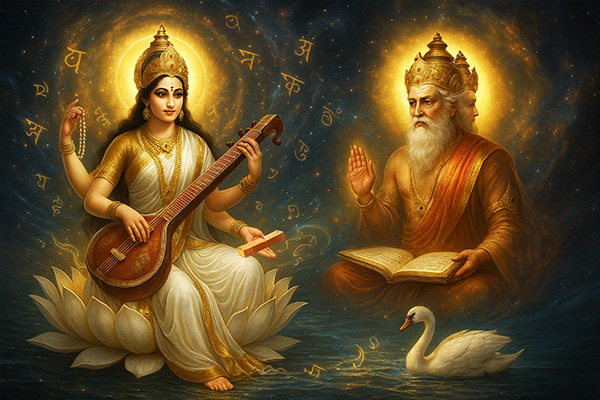
Goddess Saraswati emerged from Bhagwan Brahma during the act of creation. Her presence brought order and understanding to the universe, giving form to wisdom and learning. She is revered as the consort of Bhagwan Brahma, sharing in the creative energy that shaped the cosmos. Together they represent the union of knowledge and creation. As the goddess of learning, Saraswati is the source of all knowledge in Hinduism. She inspires education, music, and the arts, guiding minds toward truth and clarity. Her role in the Hindu pantheon is central as the force that awakens intelligence and creativity. She embodies the power of wisdom that sustains spiritual growth and cultural expression.
Symbols and Associated Elements

Goddess Saraswati is depicted with a swan vahana that represents discernment and the ability to separate truth from illusion. The swan reflects her link to purity and sharp intellect. She holds a veena that symbolizes mastery of music and the creative arts. The sound of the veena expresses the harmony of knowledge and art. A book in her hand stands for learning and the eternal pursuit of wisdom. The rosary represents spiritual discipline and the union of knowledge with meditation. Unlike many deities, she carries no weapons, showing that intellect and wisdom overcome ignorance without force.
Astrological Association
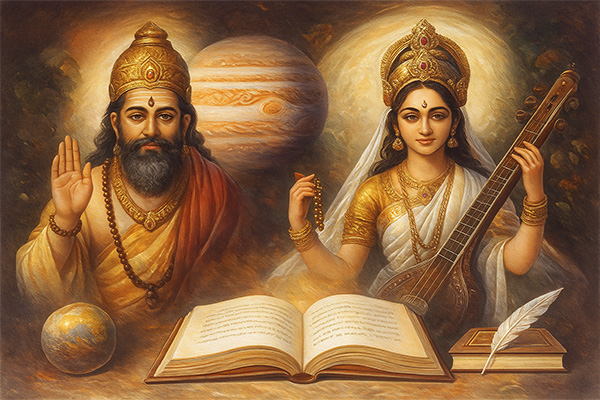
Goddess Saraswati is closely linked with the planet Jupiter, known in Vedic astrology as Guru or Brihaspati. Jupiter represents wisdom, higher learning, and spiritual insight, all qualities embodied by Saraswati. Jupiter’s influence governs education, philosophy, and righteous living. Worship of Saraswati strengthens Jupiter’s positive effects, bringing clarity of thought, improved memory, and intellectual growth. It supports academic success, creativity, and the pursuit of knowledge, while also fostering spiritual growth and moral strength.
Significance of Saraswati

Goddess Saraswati embodies Jnana Shakti, the power of pure knowledge that drives intellect and wisdom in Hindu philosophy. She represents the clarity that leads seekers toward spiritual awakening. The Saraswati Upanishads praise her as the eternal source of learning and the guiding light of Vedic thought. In Vedanta, especially Advaita Vedanta, she symbolizes the realization of ultimate truth beyond illusion. Tantric traditions link her to the Vishuddha Chakra at the throat, the center of speech and expression. Her presence in rituals and study emphasizes the goddess of knowledge importance as the force that unites wisdom with devotion and meditation.
Worship and Festivals
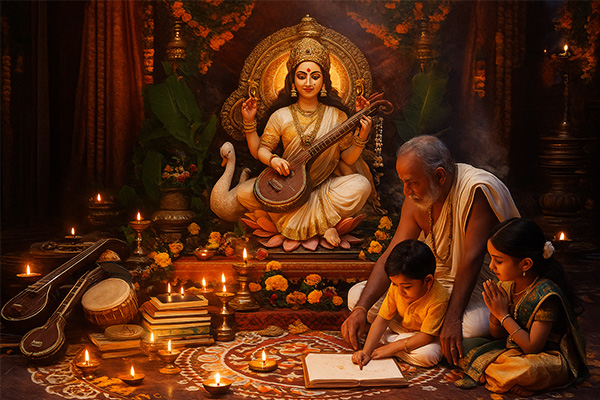
Saraswati Puja is a key ritual where devotees place books, musical instruments, and tools of learning before Goddess Saraswati to seek her blessings. Vasant Panchami marks the start of spring and is widely celebrated with yellow clothes and offerings to honor her wisdom. During Navratri, the last days in South India focus on Saraswati. Books and instruments are arranged for worship, and children begin their education with prayers for guidance. In Bali, she is venerated as Dewi Saraswati with ceremonies that honor knowledge and art. Across the world, devotees perform Saraswati worship rituals at homes and temples, reflecting her global presence and lasting influence.
Iconography and Symbolism
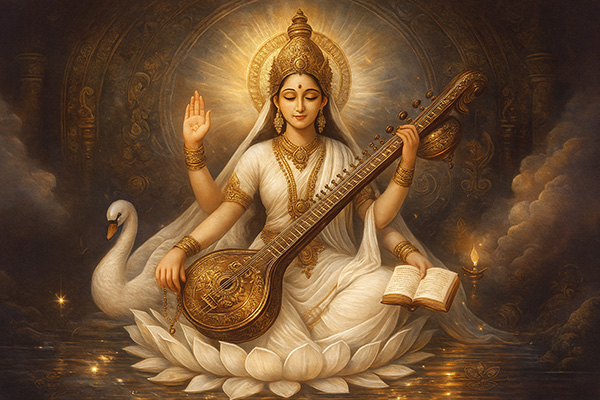
Goddess Saraswati is depicted in a white dress that reflects purity, clarity, and spiritual light. This color highlights her role as the goddess of purity and wisdom and her detachment from worldly desires. Her serene expression shows the calm of a mind focused on knowledge and truth. She is seated on a lotus, a symbol of supreme knowledge and spiritual elevation. The lotus symbolism points to her power to rise above distractions and guide seekers toward higher understanding. A white swan sometimes accompanies her, representing discrimination between truth and illusion. Saraswati has four arms meaning mind, intellect, alertness, and ego transformed by knowledge. In her hands she holds a veena for the arts, a book for sacred learning, and a rosary for spiritual discipline, with one hand raised in blessing. Her Saraswati mudras, especially the chin mudra of wisdom and teaching, convey inner balance and the pursuit of enlightenment. In temples and classical art she appears in murals and sculptures as the embodiment of poetic grace and musical depth, inspiring devotees toward learning and spiritual growth.
Scriptural References
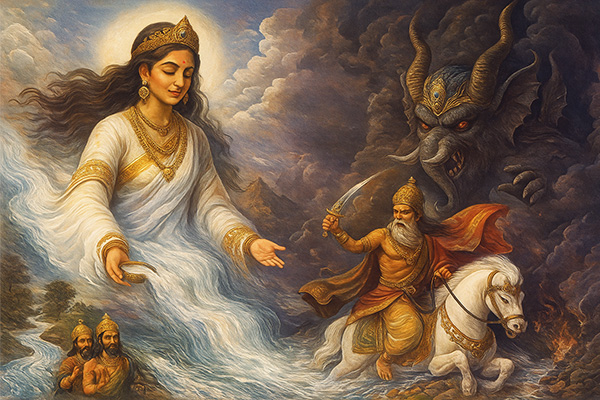
Goddess Saraswati is the Mother of the Vedas and is praised across Indian literature from 1000 BC to 1500 AD. The Shanti Parva of the Mahabharata calls her the celestial creative symphony who appeared when the universe was created by Bhagwan Brahma. Book Two of the Taittiriya Brahmana names her the mother of eloquent speech and melodious music. Early Rig Vedic hymns describe her as a mighty river flowing from heaven to earth. Later Vedic texts record that the river disappeared at Vinasana and merged invisibly with the Ganga and Yamuna. The sanctity of the Ganga is linked to the life giving waters of the ancient Saraswati. In Rig Veda 6.61.7 she joins Bhagwan Indra to destroy the demon Vritra who withheld the earth’s waters. She is the earliest river goddess in the Indian tradition, inspiring later reverence for Ganga. The Vedas also connect her with medicine and healing, and the Satapatha Brahmana invokes her aid against sickness alongside the twin healer gods Asvinas.
Birth of Goddess Saraswati
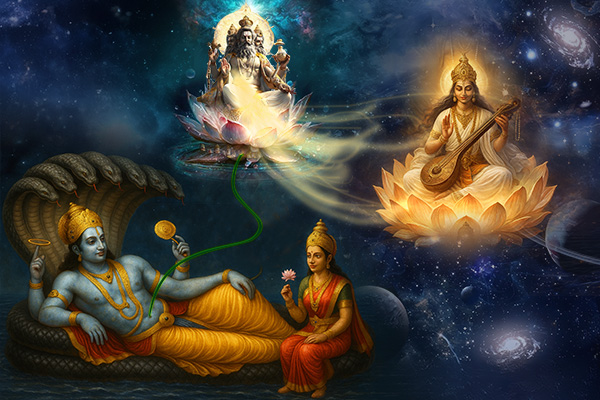
Saraswati first appears in the Rigveda as the sacred river goddess, praised for nourishing lands and minds. Over time she merged with the Vedic goddess Vac, becoming the embodiment of speech and wisdom. Puranic legends describe her emergence during the creation by Bhagwan Brahma, where her knowledge shaped the universe. Some stories also connect her to the Samudra Manthan, the churning of the cosmic ocean, as a divine force of purity. In the Mahabharata, Saraswati is honored as both a holy river and the eternal source of learning, uniting her natural and spiritual origins into one timeless goddess of intellect and eloquence.
Legends and Stories of Saraswati
Saraswati Cosmic Order
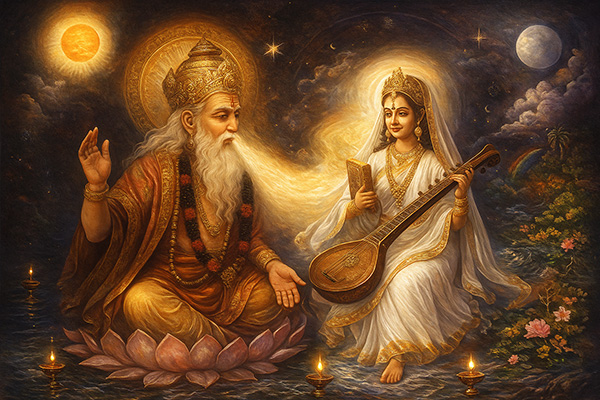
After Bhagwan Brahma created the universe, he found it lacked form and harmony. To guide creation, he brought forth Goddess Saraswati from his mouth as the embodiment of knowledge and speech. She directed the formation of the Sun, Moon, stars, oceans, and seasons, earning the name Vagdevi. Her wisdom established rhythm and balance, ensuring that cosmic order and the flow of knowledge would endure.
Saraswati Soma Plant Story
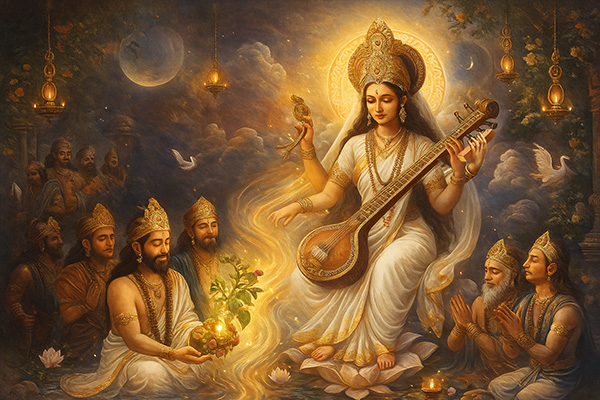
When the Gandharvas stole the sacred Soma plant vital to Vedic rituals, the gods prepared for war. Saraswati chose wisdom over conflict and enchanted the Gandharvas with divine music from her veena. Captivated, they returned the Soma in exchange for her musical teachings. This Saraswati mythology story shows how refined intellect and artistry can resolve tension without violence.
Brahma Saraswati Curse
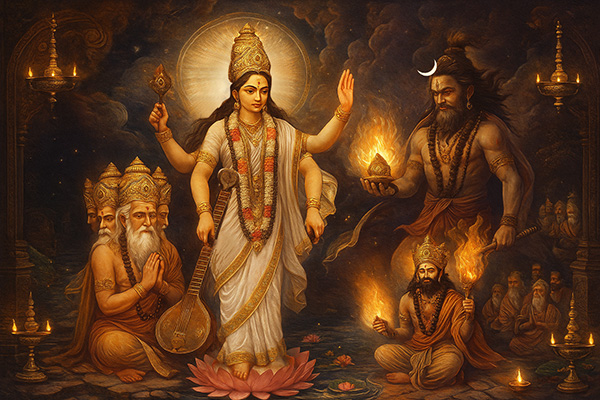
Legends describe Saraswati’s birth from Brahma’s forehead, radiating unmatched beauty and intellect. Brahma grew five heads to follow her in every direction, consumed by desire. Disturbed by his obsession, she cursed him to have few temples. Bhagwan Shiva, as Bhairava, cut off Brahma’s fifth head to restore cosmic balance. Though Brahma later performed a cleansing yagna with Saraswati as his wife, their union remained distant, underlining her independence and moral strength.
Saraswati Vadavagni Fire
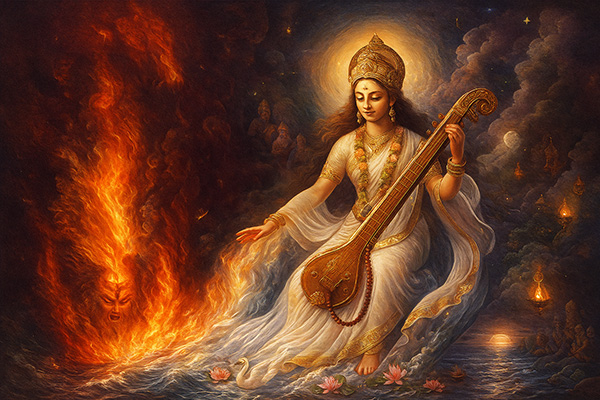
In another Saraswati mythology story, a cosmic fire called Vadavagni threatened to destroy creation. Saraswati transformed into a mighty river and carried the raging flames into the ocean, subduing their force. This act affirmed her role as both a creative power and a protector of the universe, sustaining dharma through wisdom and compassion. These legends reveal Saraswati as the goddess of knowledge and purity who preserves universal harmony, resolves conflict, and upholds spiritual law.
Goddess Saraswati: Names, Festival and Symbols
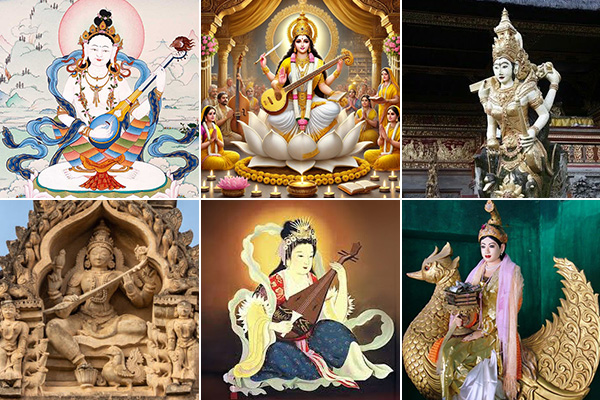
Goddess Saraswati is known by many names that highlight her divine qualities. Sarada means giver of essence, Brahmi is wife of Brahma, Mahavidya and Maha vidya signify supreme and transcendent knowledge, Bharati stands for eloquence, Arya means noble one, Maha Vani is the transcendent word, Kamadhenu shows her as the wish fulfilling source, Dhaneshvari is the divinity of wealth, and Vagishvari is the mistress of speech. Vasant Panchami, the fifth day of spring, is dedicated to her and celebrated in homes, temples, and schools. She is honored not only by Hindus but also in Buddhism and Jainism, and her worship extends to Japan, Vietnam, Indonesia, and Myanmar. Saraswati is depicted as a graceful woman with snow white skin dressed in pure white or yellow clothes. White represents the purity of spiritual knowledge. She usually sits on a white lotus, symbol of absolute truth, or rides a white swan, earning the name Hamsa Vahini. Her four hands show omnipresence and power. She holds the sacred Vedas, a necklace of white pearls for meditation, a pot of holy water for creation and purification, and the veena that reflects her mastery of music and the arts. Often shown near a flowing river and dressed simply with minimal jewelry, she embodies pure knowledge and a life beyond material desire.
Spiritual Lessons from Saraswati
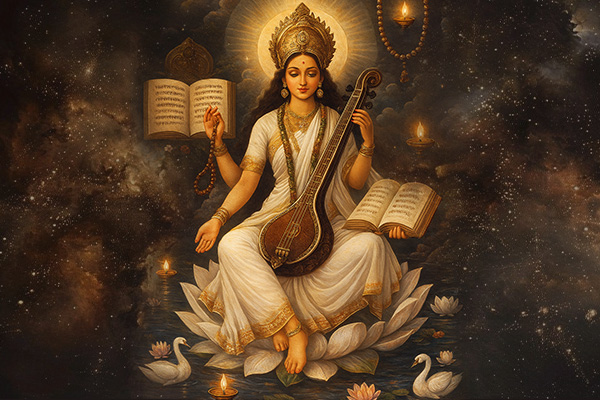
Goddess Saraswati teaches that wisdom and purity are the true safeguards of life. Her presence shows that knowledge is the greatest protection against ignorance and confusion. Her teachings stress intellectual clarity and the need for self-control. She inspires seekers to use learning with compassion, turning insight into service for the good of all.
Saraswati’s example urges the ethical use of knowledge, where intellect guides actions toward harmony and spiritual growth. She proves that wisdom, when joined with virtue, leads to lasting victory over darkness.
Saraswati Puja Vidhi at Home
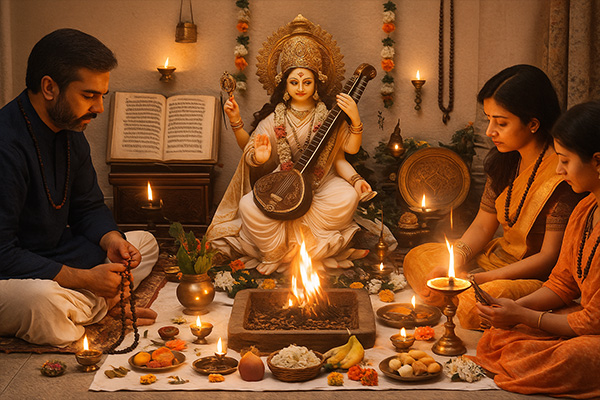
Required Materials for Saraswati Puja
- Image or idol of Saraswati
- Clean puja altar
- Shallow clay pan
- Three layers of mud
- Sapta Dhanya or Navadhanya (seven or nine types of grains)
- Pure water, preferably Ganga jal
- Kalash (holy pot)
- Supari (betel nut)
- Coins
- Akshat (turmeric mixed raw rice)
- Durva grass
- Five mango leaves
- Coconut
- Sandalwood paste
- Kumkum
- Fresh white flowers
- Incense sticks
- Diya (oil lamp)
- Fruits, sweets, and prasad
- Clean cloth for seating
- Mala for chanting
Saraswati Puja Step by Step
- Clean the puja area and place the idol or picture on a white cloth.
- Arrange books, instruments, and study materials near the altar.
- Light the lamp and incense sticks.
- Offer flowers, fruits, and sweets while chanting Saraswati Stotra or other Saraswati mantras.
- Perform Saraswati Aarti with devotion.
- Conclude with prayers seeking wisdom, clarity, and knowledge.
Chanting and Aarti Process
- Begin with a Ganesh invocation to remove obstacles.
- Recite Saraswati Vandana or Saraswati Stotra, such as “Om Aim Saraswatyai Namah,” using a mala for mantra repetition, ideally 108 times.
- Offer naivedya of fruits or sweets and perform aarti with a lit camphor or ghee lamp while singing the Saraswati Aarti.
- Conclude by seeking blessings for wisdom and clarity, then distribute prasad to all participants.
This sequence maintains purity and devotion, completing the Saraswati Puja with respect and proper ritual order.
Saraswati Mantras
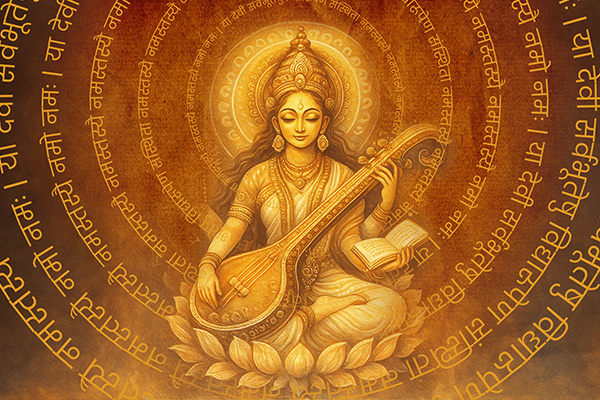
Goddess Saraswati, the source of knowledge, music, and arts, is honored through powerful chants that sharpen memory, improve speech, and inspire creativity. Reciting these mantras invites wisdom, focus, and spiritual growth.
Beeja Mantra
॥ Om Aing Saraswathye Namah Om ॥
Salutations to Goddess Saraswati before and after study or creative work.
Vidya Mantra
॥ Saraswati Namasthubhyam Varade Kamarupini Vidhyarambam Karishyami Siddhir Bhavathume Sadha ॥
Invokes memory, focus, and success in learning.
Maha Saraswati Mantra
॥ Om Aim Hrim Kleem Maha Saraswati Devaya Namaha ॥
Strengthens understanding and makes learning easier.
Other Saraswati Mantras and their Meanings
Vagvadini Mantra
॥ वद वद वाग्वादिनी स्वाहा ॥
Vad Vad Vagvadini Svaha
Grants eloquence and the power of speech.
Om Aim Kleem Sauh
ॐ ऐं क्लीं सौः
An offering of devotion to awaken divine knowledge.
Om Aim Mahasarasvatyai Namah
ॐ ऐं महासरस्वत्यै नमः
Reverent bow to Maha Saraswati for supreme wisdom.
Om Aim Hreem Shreem Vagdevyai Sarasvatyai Namah
ॐ ऐं ह्रीं श्रीं वाग्देव्यै सरस्वत्यै नमः
Prayer for intelligence and spiritual clarity.
Om Arham Mukha Kamala Vasini Papatma Kshayamkari Vad Vad Vagvadini Saraswati Aim Hreem Namah Svaha
ॐ अर्हं मुख कमल वासिनी पापात्म क्षयम्कारी वद वद वाग्वादिनी सरस्वती ऐं ह्रीं नमः स्वाहा
Seeks removal of negativity and blessings of knowledge and wealth of wisdom.
Ya Devi Sarvabhuteshu Vidyarupena Samsthita
या देवी सर्वभूतेषु विद्यारूपेण संस्थिता नमस्तस्यै नमस्तस्यै नमस्तस्यै नमो नमः
Honors the goddess as the embodiment of knowledge in all beings.
Maho Arnah Saraswati Pracheyati
महो अर्णः सरस्वती प्रचेयति केतुना धियो विश्व विराजति
Prayer for enlightenment and the removal of fear through divine wisdom.
Benefits of Worshipping Saraswati
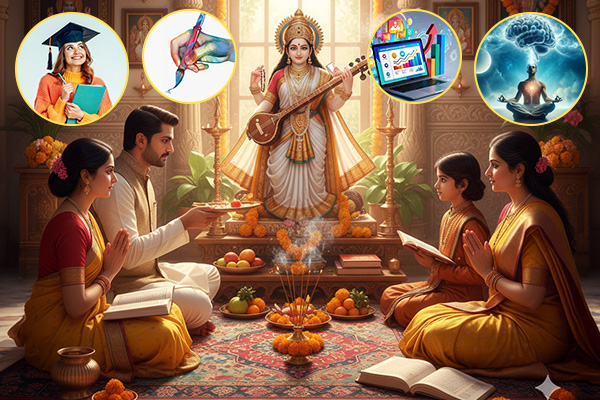
Worship of Goddess Saraswati brings profound spiritual, mental, and material rewards. Her grace offers goddess of wisdom blessings that inspire students, artists, scholars, and all seekers of knowledge. Spiritually, her worship purifies the mind, dispels ignorance, and leads to self-realization and spiritual growth. Saraswati awakens inner clarity and guides devotees toward higher consciousness and enlightenment. Mentally, she sharpens intellect, strengthens focus, and grants improved memory. Her presence encourages eloquence, creativity, and artistic talent, supporting those engaged in music, literature, and education. Materially, Saraswati benefits include academic success, recognition in the arts, and professional growth in creative fields. Her blessings increase confidence, positive thinking, and clarity of decision making while ensuring auspicious beginnings in learning and creative work.
Key Benefits
- Purifies the mind and removes ignorance
- Enhances wisdom, knowledge, and learning ability
- Sharpens memory and concentration
- Improves eloquence and communication skills
- Fosters creativity and artistic talents
- Promotes academic success and career growth
- Supports spiritual growth and self-realization
- Builds confidence and positive thinking
- Brings clarity of thought and wise decision making
- Blesses new educational and creative pursuits
Temples Dedicated to Saraswati
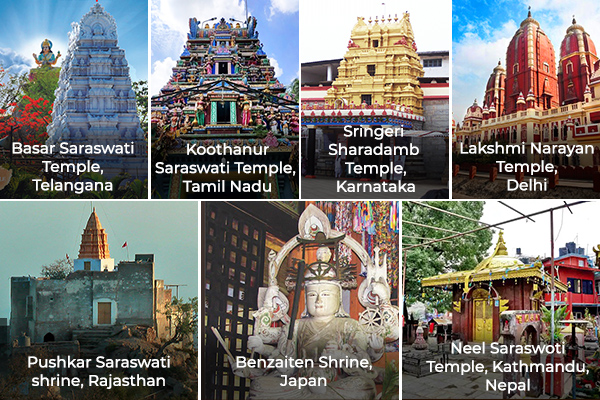
The Basar Saraswati temple in Telangana is one of the most visited Saraswati temples in India, where children begin their studies with Aksharabhyasam rituals. Koothanur Saraswati in Tamil Nadu is the only temple in that state solely devoted to the goddess and draws devotees during Navratri. The Sringeri Sharadamba temple in Karnataka celebrates her as Sharada, with grand rituals and Vedic recitations that attract scholars and spiritual seekers. In Rajasthan, the Pushkar Saraswati shrine stands near the sacred lake and is visited by pilgrims seeking wisdom and blessings. Outside India, Saraswati temples and shrines exist in Nepal, Indonesia, and among Hindu communities worldwide, where festivals and traditional pujas honor the goddess of wisdom and learning.
Presence in Other Traditions
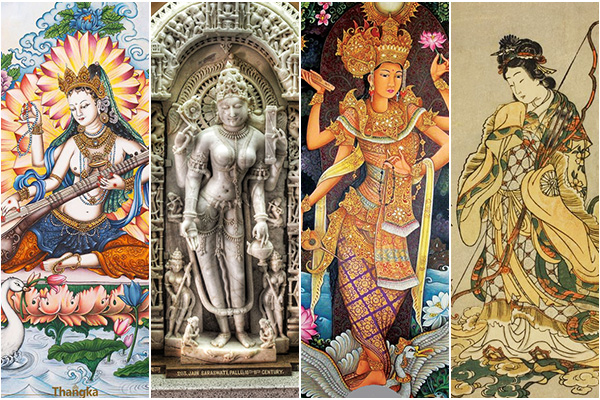
Saraswati in Buddhism is honored as a guardian of learning and music. In Tibetan Buddhism she is known as Yangchenma, the goddess of wisdom and melodious speech who protects scholars and teachers. In Jainism she is revered as the goddess of knowledge and is worshipped before beginning sacred texts or study. Temples across India show her seated with scriptures and a veena, reflecting her role in education and spiritual clarity. Saraswati in Southeast Asia spread through Indonesia and other regions where she is celebrated in festivals like Balinese Saraswati Day. In Japan she is worshipped as Benzaiten, a deity of music, eloquence, and art, showing her enduring cross cultural influence.
Rudra Centre Saraswati Products & Puja Services
Goddess Saraswati Brass Idol
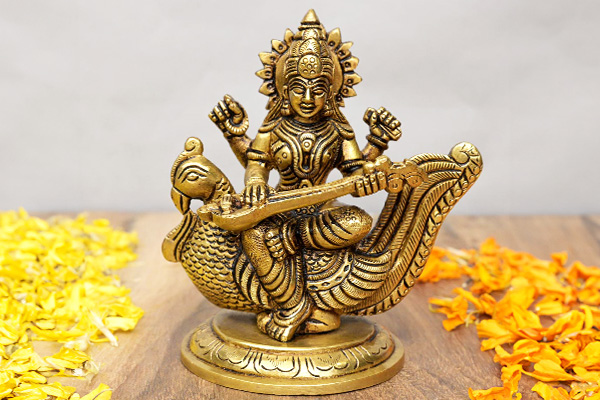
A brass idol seated on a lotus pedestal, in the classical pose playing the veena, with upper hands holding book and rosary, and a swan at the base symbolising purity. Ideal for study rooms, mandirs, gifts for students.
Saraswati Yantra

Brass yantra available in antique or gold finish, in sizes from 3 to 12 inches, etched and energised. Incorporates sacred geometry, auspicious for knowledge, creativity, speech. Comes with optional puja kit.
Hand Carved Sphatik Crystal Saraswati Idol (325 gms)
.jpg)
Sphatik (crystal) idol, detailed carving, seated on lotus, holding veena; sacred crystal enhances clarity, memory, concentration. Best for scholars, creative professionals.
Shree Saraswati Yantra on Lapis Lazuli

Yantra printed on natural Lapis Lazuli stone, with stand. Combines clarity and spiritual awareness of lapis with divine geometry of Yantra. Gift quality set.
Saraswati Yantra Bracelet (925 Sterling Silver)
.jpg)
Bracelet with Saraswati yantra in sterling silver, available with chain or adjustable thread. Promotes concentration, creativity, spiritual wisdom.
Hanging Saraswati Yantra Silver (Locket/Rosary)
.jpg)
Round pure silver yantra disc (24 mm), Yantra on one side, Goddess image on the other, strung on crystal rosary with a 5-mukhi bead. Meant to hang in children’s rooms, study areas.
Goddess Saraswati Puja Service at Sangam Prayagraj
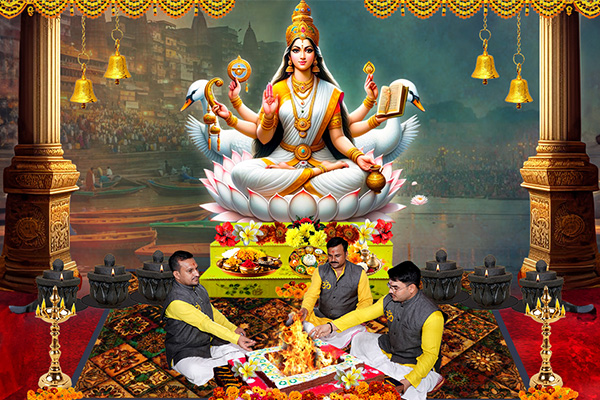
View Saraswati Puja Service at Sangam Prayagraj
A sacred puja performed at Triveni Sangam (Prayagraj), where the mythical rivers Ganga, Yamuna and Saraswati meet. Includes chanting, abhishek, yantra and idol puja, homa, aarti and personalized Sankalp to invoke Saraswati’s blessings for wisdom, creativity and academic success.
Tridevi Goddess Saraswati Lakshmi Kali Puja & Homam
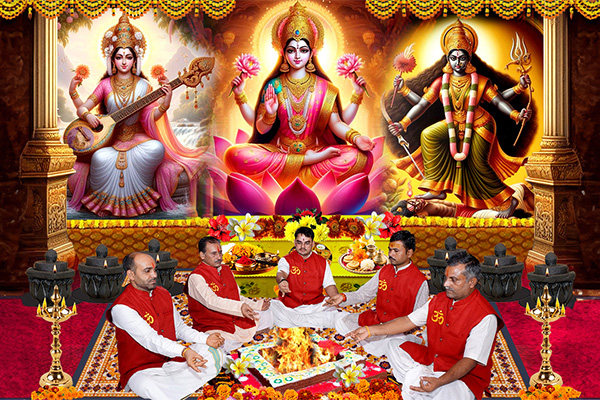
View Tridevi Goddess Saraswati Lakshmi Kali Puja service
Comprehensive puja invoking the Tridevi; Saraswati, Lakshmi, Kali, to aid spiritual and material growth. The Ritual includes:
- Invocation of all three Goddesses as primary manifestations of Adi Parashakti
- Shlokas and mantras from Vedic scriptures specific to Saraswati, Lakshmi, Kali
- Services: Kalash Sthapana, Panchang Sthapana, Ganesh Pujan, Navagraha Pujan, Yantra Pujan with abhishek, chanting of Laxmi Suktam, Kali Stotram, Saraswati Stotram, 11,000 mantra japas, Aarti, Pushpaanjali
- Duration 1 day (≈ 4 hours); five priests conduct the puja
- Live participation via WhatsApp or Skype; video & photo updates; a Puja Tokri optional (with prasad, yantras, rudraksha)
Conclusion: Eternal Source of Wisdom
Goddess Saraswati embodies eternal wisdom, guiding seekers of truth and learning through every stage of life. Her serene presence and gentle gaze awaken clarity within, showing that real understanding is discovered rather than collected. Her veena carries the power of Saraswati inspiration, filling the world with creativity and knowledge. As the goddess of arts, she transforms confusion into insight and hesitation into confident expression. Her blessings nurture imagination, spark innovation, and honor the light of knowledge as the highest gift. By following her path, we embrace lifelong learning and the courage to create. Saraswati’s influence endures in every spark of inspiration, shaping a world where wisdom and creativity grow together.


-in-Astrology.jpg)
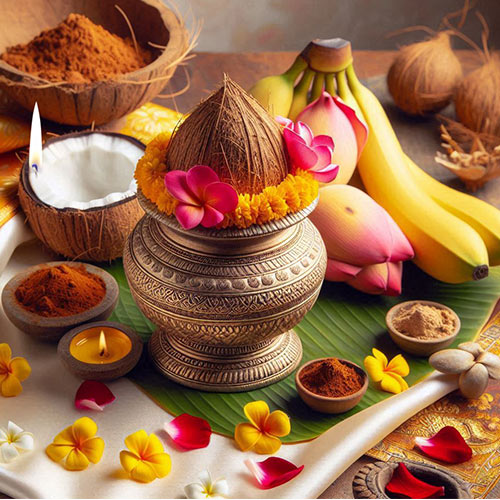

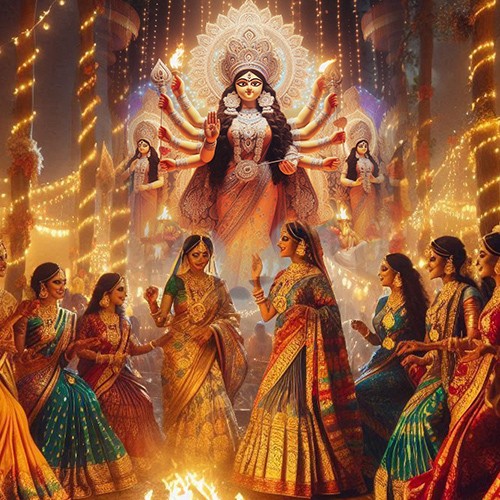
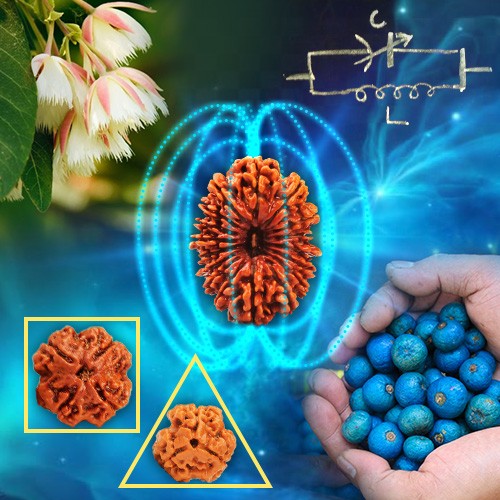

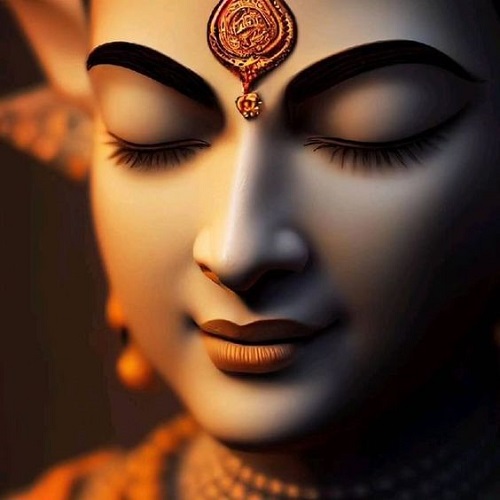
.jpg)

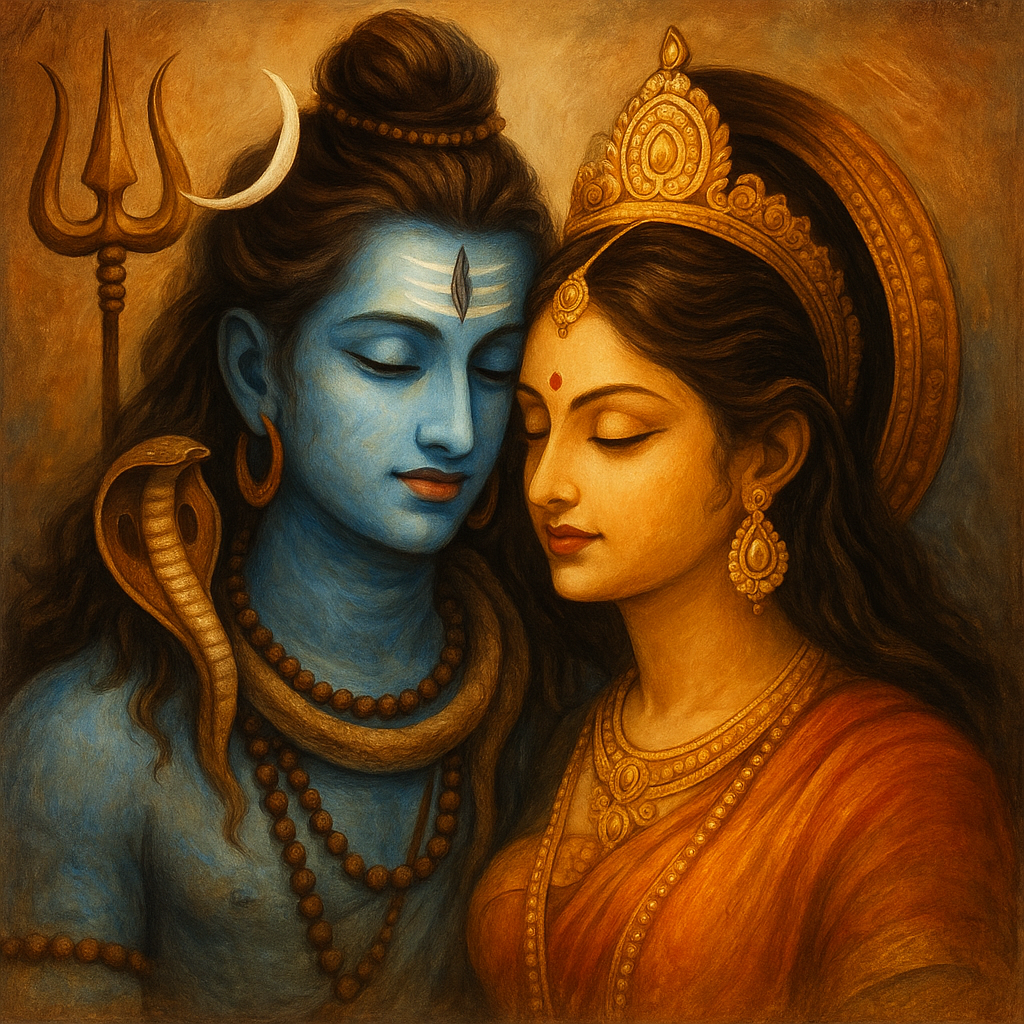
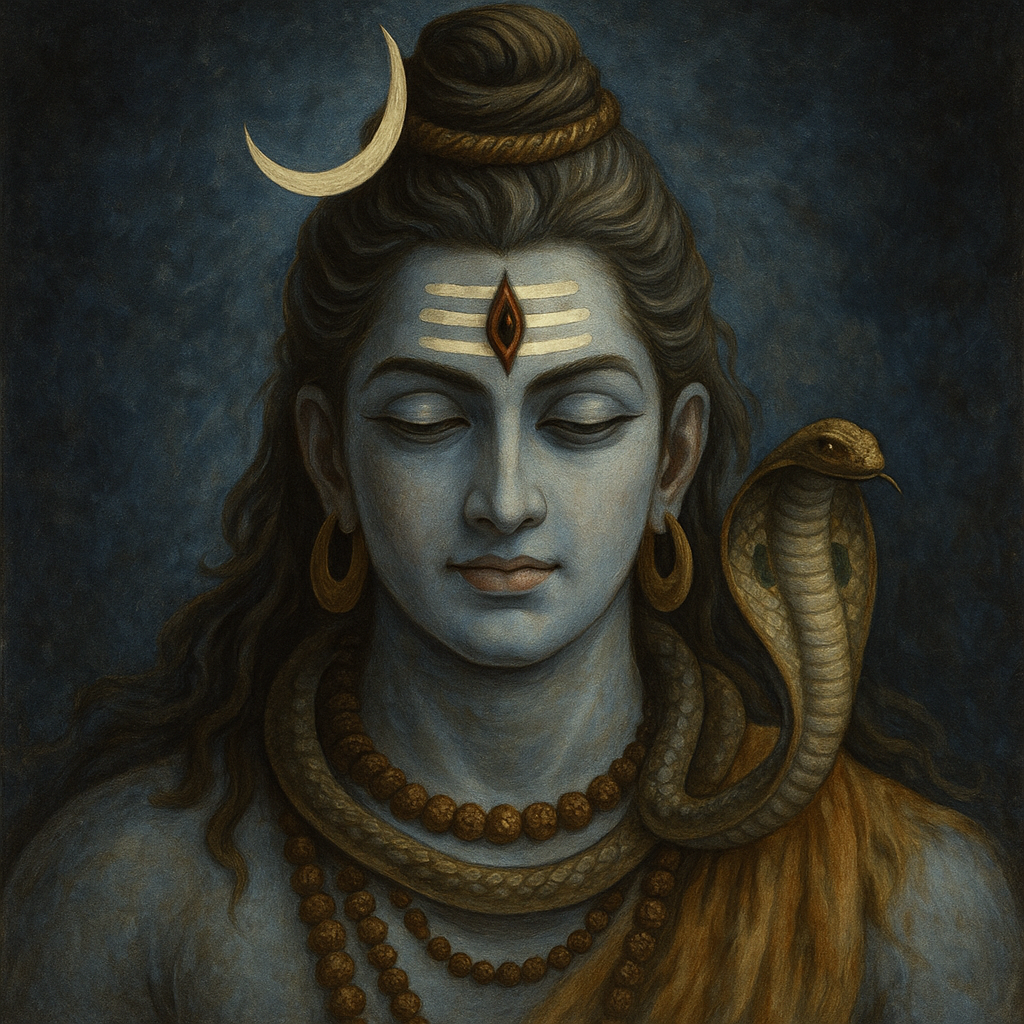
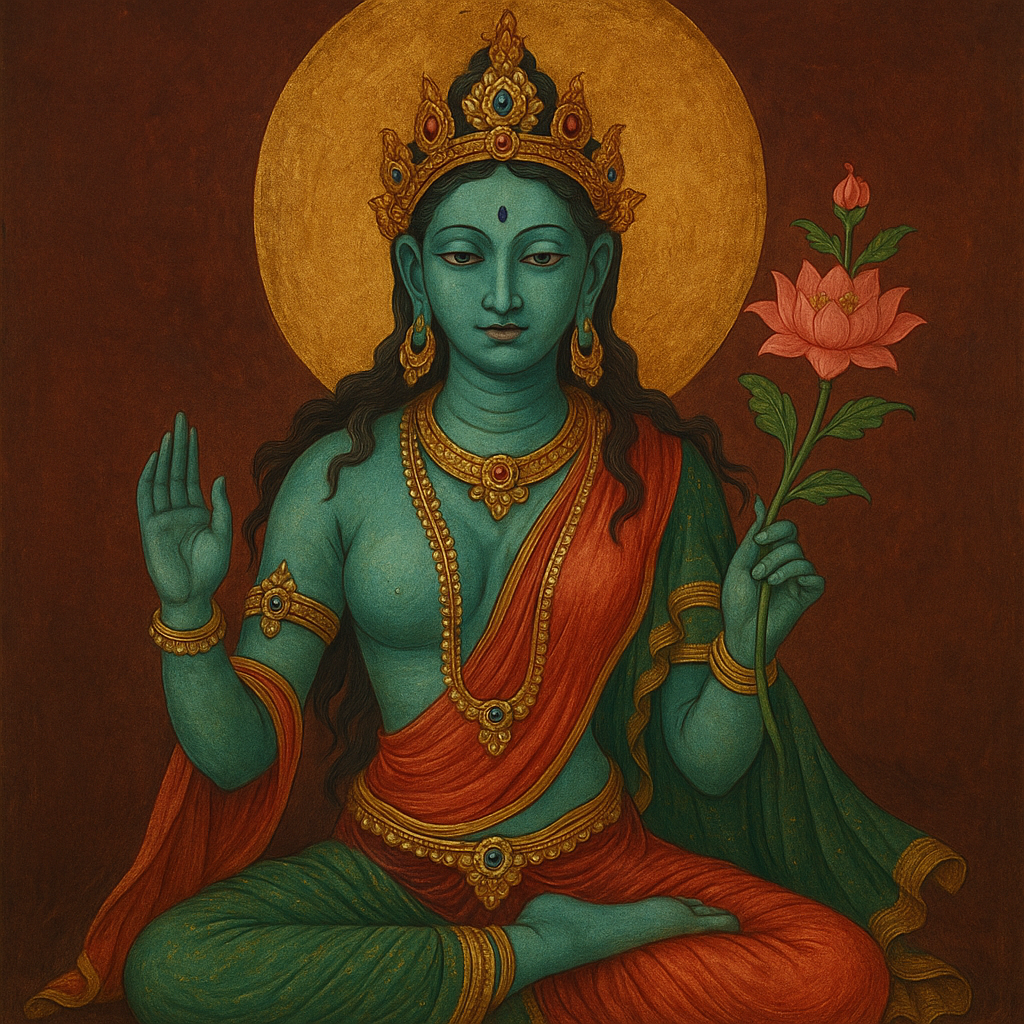
Comments 0
Leave your thought here